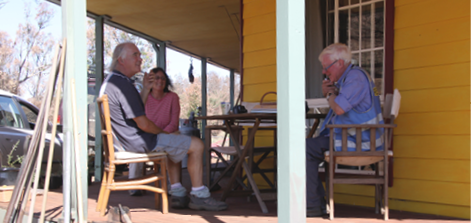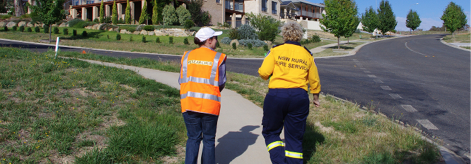Experience counts: research finds lessons from bushfires
Nathan Maddock
Research teams are helping communities across many states to gather valuable safety lessons from recent destructive bushfire seasons.
Article
The last few summers have seen a return to hot conditions, following cooler and wetter than normal conditions, thanks to the influence of La Nina weather patterns. Extreme temperatures, ferocious winds and dangerous fire weather have been faced across southern Australia, resulting in large and destructive bushfires.
In the summer of 2012-13, the worst were in Tasmania and NSW. The 2013-14 fire season started early, with more major blazes across NSW in October 2013, followed by devastating fires in Western Australia and South Australia in January 2014.
A bushfire of the intensity of the Forcett fire, which flared up under catastrophic conditions on 4 January 2013, had not been experienced in Tasmania since Black Tuesday in 1967. While this bushfire did not burn into Hobart, as was the experience in 1967, 193 homes were destroyed and 24 000 hectares of bushland and pasture were burnt. In the town of Dunalley, a third of all homes, as well as the primary school and police station, were razed. Boomer Bay, Connellys Marsh, and Murdunna were also devastated and, like Dunalley, significant infrastructure was damaged or destroyed. There was social dislocation and the impact on communities was profound.
In the same fire season, NSW experienced challenging bushfire conditions. Catastrophic fire danger ratings were issued for the first time across a number of areas, including urban centres. A number of major bushfires burned across the state and 62 houses were destroyed; 53 from the Coonabarabran area of central NSW alone.
In October 2013, bushfires again threatened many communities, with more than 200 homes lost across the greater Blue Mountains, the Port Stephens area and Wingecarribee Shire in NSW. Western Australia and South Australia were also not spared, with destructive fires in the Perth Hills and to the north and the fringes of Adelaide.
To maximise lessons learnt during these serious fire seasons, the fire services in NSW, Tasmania, South Australia and Western Australia individually requested that the Bushfire CRC, and its successor the Bushfire and Natural Hazards CRC, undertake independent, community-based research. This research builds on similar projects undertaken by the CRC following the Black Saturday fires in Victoria in 2009, and the Perth Hills and Lake Clifton (Western Australia) bushfires in 2011; adding to the collective knowledge.
Both the Tasmania and NSW research programs, or task forces, focused on people’s preparation, decision-making, and actions taken during the fires. For both projects the research team comprised of Australia’s leading bushfire researchers from Bushfire CRC partner universities of the Australian National University, Central Queensland University, La Trobe University, RMIT, University of Canberra, University of Tasmania, University of Western Australia, and the University of Canterbury, NZ.
Researchers visited residents in the various fire-impacted areas to learn from their experiences with the bushfires, focusing on their knowledge of bushfire risk, preparations before the bushfire, and their actions taken on the day.
Bushfire CRC CEO, Gary Morgan, indicated that the research is of national significance. ‘The data gathered is informing not just the residents of Tasmania and NSW, nor just the Tasmania Fire Service and NSW RFS, but communities and fire agencies across Australia and New Zealand,’ he said.
Tasmania research – fire in a tourist hotspot
The research task force team visited the areas affected by the Forcett bushfire in the weeks immediately following the fire. From a base in the car park of the Dunalley pub, the team was led by the University of Tasmania Prof. Timothy Skinner (now at Charles Darwin University) and Dr Jim McLennan from La Trobe University. A total of 226 interviews were conducted of residents across the Tasman Peninsula, in both the effected and surrounding areas. This was made possible with the assistance of staff at the University of Tasmania Rural Clinical School and the Menzies Research Institute.
Damien Killalea, Director of Community Fire Safety at the Tasmania Fire Service (TFS) indicated that the bushfire presented a unique opportunity to assess people’s responses.
‘There were some unique elements about this fire. The conditions were classed as catastrophic at points and, given the time of year was the New Year holiday period, there were a large number of tourists in the area. These tourists may not have been exposed to TFS safety messages,’ said Mr Killalea.
The research also looked at what TFS staff had learnt from Black Saturday, and the changes that have been made to bushfire community safety in Tasmania since that time.
‘This bushfire was the first time the TFS has applied on a large scale what we have learnt since 2009. It was a chance to test the range of measures we have put in place.
‘The research was vital in that it allowed us to see and measure how the various community safety initiatives put in place in recent years were picked up by the community. The fact that no one died in the conditions that we saw was a great relief.
‘The findings from this research are wide-reaching and will inform development of Tasmanian Bushfire Policy.
‘Getting independent research findings from the Bushfire CRC is invaluable. For decades, fire agencies made decisions about what was good for the community, and about what they [fire agencies] were going to do, which often overlooked things like public safety. Listening to community members tell us about what they went through and getting direct feedback about what they experienced and how they felt and reacted, is the best way to inform future policy and practices,’ Mr Killalea said.

Image: NSW Rural Fire Service
Dr Jim McLennan interviews residents after the fires near Coonabarabran, NSW.
NSW research –record-breaking fire seasons
January 2013 saw temperature records broken across NSW, with many fires occurring. Three of the most significant were at Dean’s Gap in the Shoalhaven, Cobbler Road near Yass, and areas around Coonabarabran. The Coonabarabran fire made international headlines when it tore through the Warrumbungle National Park and Siding Spring Observatory.
Rural Fire Services Commissioner, Shane Fitzsimons, noted that these were major fires. ‘Both the Dean’s Gap and Cobbler Road fires started under catastrophic conditions on 7 January, while the Coonabarabran fire that started on 12 January was particularly large, intense, and had a significant impact on the community.
‘The NSW RFS took this opportunity to take a close look at what people did before, during and after the fires, and to see what could be learned from the experiences. The research is possible due to the continuing relationship between the NSW RFS and the Bushfire CRC. Research in this area helps all agencies better understand people’s actions and lessons can be identified,’ Commissioner Fitzsimmons added.
Throughout February and March, the research team visited the areas surrounding Coonabarabran, Yass, and the Shoalhaven to interview fire-affected residents. Over 230 semi-structured interviews were conducted with community members. In addition, an online survey was conducted with over 970 residents in affected communities.
CRC Research Manager, Lyndsey Wright, said the three fires were chosen for the research due to the extent of areas burnt and the potential for extensive losses, particularly related to houses, stock and, possibly, lives.
‘A large number of houses were lost around Coonabarabran and stock losses were particularly significant in the Coonabarabran and Yass shires. But both could have been much higher if it were not for a combination of fortunate weather changes, enormous efforts by RFS volunteers, and the response from residents to minimise the impacts,’ said Ms Wright.
While this is the first time the CRC has conducted this type of research in NSW, the experience of the research team, particularly Chief Investigator, Dr Jim McLennan, was invaluable. Dr McLennan is involved with similar research1 that shows the degree of readiness residents of a particular area may be for a fire.
‘Previous research task forces in Victoria, Western Australia and Tasmania demonstrate that readiness for a bushfire threat in a given location is usually related to the history of bushfire in that area. For any given household, a bushfire is a rare event, with most households in bushfire-prone areas not threatened by a fire in the life of the household. Therefore, perceived risk of a bushfire is commonly low.
‘Few residents of bushfire-prone areas are actually prepared and ready to leave safely. A majority of people do not have any real appreciation of what a serious bushfire entails, because they are such rare events for any given location,’ Dr McLennan said.
The research considers the preparedness of long-term residents, as well as ‘tree change’ or ‘sea change’ residents (people who have moved from a city to more rural or coastal areas, attracted by the lifestyle they afford). Previous research shows that ‘lifestyle’ residents may not be as prepared as people who have lived in a particular area for a long time.
‘We look at how confident residents are in their ability to safely defend or evacuate, and how well they understand what this actually involves. Are people fully aware of the physical efforts required to safely defend a home from bushfire, and the significant mental effort required too?
‘Similarly, what is the understanding of the right time to evacuate to ensure the safety of all members of the household?’ Dr McLennan said.
Adding to the depth of knowledge is the interviews from the greater Blue Mountains, Port Stephens area and Wingecarribee Shire bushfires in October 2013. On this occasion, more than 190 interviews were conducted with residents about their experiences during the fires.
Longer-term benefits
TFS, NSW RFS, and fire agencies across Australia and New Zealand will benefit from the research conducted well into the future. Ms Wright said ‘Community participation in the research was fantastic, which enabled a good cross section of community members to be interviewed. The data provides substantial depth to explore for a long time.’
Dr McLennan drew comparisons between bushfire safety and road safety. ‘Communicating community bushfire safety is not easy; there is no silver bullet. Similarities can be made with attempts to reduce the road toll. It is now second nature to buckle up, stay under 0.05 and, more recently, practice safe driving with mobile phones. But the reduction in the road toll is the cumulative effect of driver education, infrastructure engineering, and law enforcement, which took decades to achieve across Australia.
‘Why would raising community bushfire safety be any easier? Fire agencies need to look for new ways to raise householder awareness of risk and encourage planning and preparation. This needs to go beyond the passive availability of community education material on websites and in paper publications,’ Dr McLennan explained.
Full research findings from the 2013 Tasmania and NSW bushfires are available at www.bushfirecrc.com/research/contract.
Similar community safety studies of the bushfire in WA’s Perth Hills, and SA’s Eden Valley, Bangor and Rockleigh areas have been investigated by the Bushfire and Natural Hazards CRC, with findings available at
www.bnhcrc.com.au.

Image: Bushfire CRC
Researchers interview residents in Yass, NSW during the study.
1 McLennan J. Elliot GE. Wright L. 2014, Bushfire survivial preparations by householders in at-risk areas in south-eastern Australia. Australian Journal of Emergency Management, v19, no2, pp.11–17.


